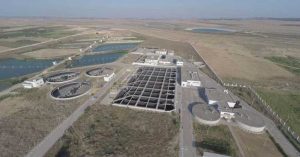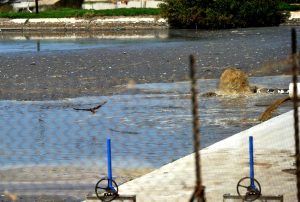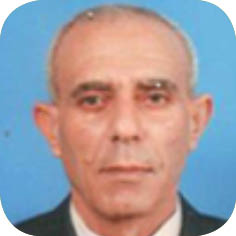Since the early stages of its establishment, the Palestinian Authority (PA) started planning to address the issue of northern Gaza’s wastewater disposal and treatment. No one can forget the accident on March 27, 2007, when one of the small lagoons full of wastewater collapsed, damaging houses and farms in Om al-Naser village and killing five innocent people. Further incidents at the wastewater disposal and treatment plant of Beit Lahia included causalities who drowned in sewage water. The problem extended beyond the plant itself, with the presence of a lake with 2 million cubic meters of sewage water posing a constant threat to the nearby houses and the thousands of people living in the area.

Since 2005, the Palestinian Water Authority has been implementing a two-phase infrastructure development plan. The first phase addressed the emergent need to evacuate the random lake in an attempt to mediate its threat and to infiltrate the effluent that was seeping into the newly constructed infiltration basins in the eastern part of northern Gaza. The second phase of the plan addressed building the new wastewater treatment facility in northern Gaza. After continued frustration over the long lifecycle of the project, which included the termination of the international contractor’s contract, the new wastewater treatment facility had been almost completed in March 2018. However, a new challenge emerged.
The contractor continued to operate and maintain the new facility, at considerable expense, with the PA being assigned responsibility for the energy supplies and chemicals needed for the treatment process. The operation and maintenance of the project should be handed over to the PA by March 2020.
International financial agencies, particularly the World Bank and the French Agency for Development (AFD), have in fact done a tremendous job in pushing the project forward financially, technically, and politically. Unfortunately, with all this support, PA organizations have still not been sufficiently qualified or equipped to absorb the challenges of such a project. In order to be ready to take over responsibility of operation and maintenance, a Palestinian team should have been assembled and recruited to join the contractor in the operation stage and become more involved in the process. In addition, the revenue-collection mechanism implemented should have been improved upon in order to cover at least part of the operational costs. Last but not least, there was a need for further development within the institutional setup among the Palestinian Water Authority, the Coastal Municipalities Water Utility, the Water Sector Regulatory Council, and the northern municipalities in order to enable them to better manage such a project.

Operational responsibilities for the facility must be handed over from the contractor to the PA in March 2020 – a time period significantly shorter than that needed to overcome the current problems facing the project. As it stands now, there will not be a capable operations team in place, the ownership of the project continues to be unclear, and no plans to improve revenue collection have been outlined. The resulting consequences will be catastrophic if a project worth over US$ 100 million is neglected. Furthermore, 32,000+ m3/day of raw sewage will not be treated and will either be disposed of in the infiltration basins designed to infiltrate treated effluent to be reused for irrigation or in the creation of a lake that poses an environmental and health disaster. Moreover, infiltrated raw sewage will merge with the aquifer water to start polluting the field of domestic wells in northern Gaza.
In light of the current scarcity of water resources, the Palestinian Water Authority had planned for a recovery-and-reuse scheme to recover infiltrated treated effluent for irrigation, where a first stage had been constructed but could not become operational without a further stage to be launched soon after with the support of AFD. It is worth noting the additional issue of the shortage of electricity needed to operate the whole scheme.
Indeed, the internal division within Palestinian politics has been a main factor in this lack of achievement, but it is not the only factor since most of the program’s activities have been created under similar circumstances. Basically, it is the role of the Palestinian government to find whatever temporary arrangements are needed to address issues of governance and revenue collection. Municipal departments in northern Gaza should show more commitment towards ownership and revenue collection, and partial subsidies by the government and the donor community should be in place.
It is worth mentioning that even the recovery-and-reuse scheme, which will be launched with AFD support to make the scheme operable after at least two years, will not lead to concrete results unless the PA starts to work immediately on governance issues related to this project.

In summary, the following practical steps should be considered by the PA in light of the water law in order to avoid catastrophic situations.
– Management arrangements for taking over responsibilities for the operation and maintenance of northern Gaza emergency sewer treatment with enough training and capacity building that should have been started more than a year ago. Options for private-sector involvement with realistic contract cost should be in place as well.
– Management and regulatory arrangements for the recovery-and-reuse scheme in northern Gaza and consideration of water consumers’ associations in the process.
– Planning for the extension of
the northern Gaza wastewater treatment facility since influent amounts are currently almost equal to the constructed capacity which will be overloaded in a few years.
– The consideration of alternatives
for treated effluent disposal in addition to the infiltration basins to avoid accumulation of non-treated effluent at threatening places or clogging of infiltration basins due to quality of effluents. A tight monitoring program to prevent aquifer contamination must be in place.


